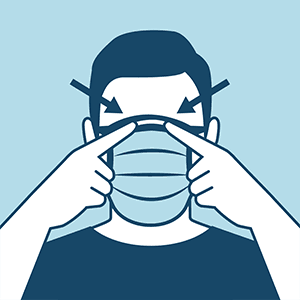Should I use a face mask during the COVID-19 pandemic?
The use of face masks has received increasing support among public health officials as an additional control measure against the spread of COVID-19. Earlier messaging seemed to indicate that masks are not useful at all in preventing spread on COVID-19. While there is some truth to the fact that non-medical grade face masks cannot fully protect against coronavirus transmission, I believe this was a calculated move by health authorities to avoid supply problems for much-needed medical masks if everyone was to go searching for masks.
As the pandemic has progressed, this messaging has slowly evolved to face coverings being considered by many jurisdictions as a key part of their relaunch strategies. This is because face coverings not only reduce the likelihood of an infected person spreading to others, they are also key in prevention face touching, a habit that can increase the likelihood of COVID-19 transmission yet hard to do away with.
In countries like Taiwan, where wearing of face masks was made mandatory in the earlier stages of the pandemic, their success in reducing the infection rate has been partially attributed to the use of face masks.
Therefore wearing a non-medical face mask during the COVID-19 pandemic can be an additional measure you can take to protect others around you. Face coverings are seen as appropriate for situations where physical distancing is not possible such as in public transit or grocery shopping.
Keep in mind that medical masks, including surgical, medical procedure face masks and respirators (like N95 masks), must be kept for health care workers and others providing direct care to COVID-19 patients. The good news is that there are now a number of options to get a non-medical mask, including DIY tutorials on making your own, and ready-made reusable cloth face masks. Regardless of where/how you get your face covering, it is important to use it properly in order to benefit from its use.
How to put on a face mask
- Ensure the face mask is clean and dry.
- Wash your hands with warm water and soap for at least 20 seconds before touching the mask.
- If none is available, use hand sanitizer with a minimum 60% alcohol base.
- Ensure your hair is away from your face.
- Place the face mask over your nose and mouth and secure to your head or ears with its ties or elastics.
- Adjust if needed to ensure nose and mouth are fully covered.
- After putting on your mask, wash your hands again with soap and water or wipe with hand sanitizer as described in Step 2.
While wearing a face mask, it is important to avoid touching your face. If you do touch your mask or face, you should immediately wash your hands with warm water and soap for at least 20 seconds. You can also use hand sanitizer with a minimum 60% alcohol base.
How to remove a face mask
- Wash your hands with warm water and soap for at least 20 seconds.
- If none is available, use hand sanitizer with a minimum 60% alcohol base.
- Remove the face covering by un-tying it or removing the loops from your ears.
- Avoid touching the front of the mask when removing it.
- It can be placed in a plastic bag temporarily if you are not at home.
- Make sure you close or zip seal the bag while storing it.
- If you plan to reuse the mask, wash it before wearing it again.
- It can be washed with hot, soapy water, or it can be washed with your other laundry.
- If throwing it out, place it into a garbage bin or plastic bag.
- After removing your mask, wash your hands again with soap and water or wipe with hand sanitizer as described in Step 2.
Important notes about using face coverings
If you take away anything from these instructions, it is that hand hygiene is still important in handling of your mask. Secondly, the face covering has to securely cover your face – snug fit around nose and chin. The mask reduces its utility if it is not fit properly. This may be a challenge for DIY homemade masks that are perhaps not rigorously designed to ensure fit. When looking at any DIY instructions online, pay attention to features that ensure an adjustable comfortable fit such as an adjustable nose clip of ear loops.


Wearing a face mask is not a substitute for physical distancing and hand washing! The best thing you can do to prevent spreading COVID-19 is to wash your hands frequently with warm water and soap for at least 20 seconds. If none is available, use hand sanitizer with a minimum of 60% alcohol base.
COVID-19 Reminders
The main modes of transmission for COVID-19 are through respiratory tract and through physical contact with an infected surface. An infected person can transmit COVID-19 through droplets released during coughing, sneezing or during regular talking. The virus can also be transmitted by touching your nose, eyes or mouth after touching a contaminated surface.
Why is soap and water, and alcohol-based hand sanitizers effective in controlling COVID-19 transmission?
COVID-19 virus has an outer sheath that encases all it (think of a skin) that is mainly made up of lipids (fats). This sheath not only protects the internals of the virus, it is also what the virus uses to attach to human cells during infection. Soap and hand sanitizer dissolves this outer sheath, in the same manner that soap breaks down grease in dishes. This disintegrates the virus and further deactivates its attachment tools therefore rendering it not infectious.
